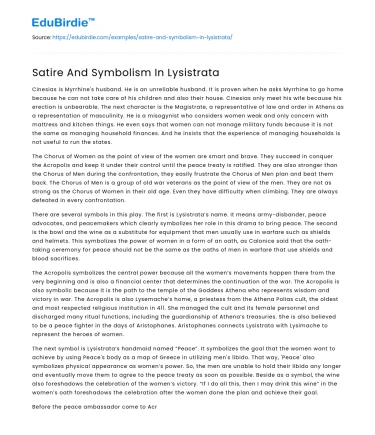Cinesias is Myrrhine's husband. He is an unreliable husband. It is proven when he asks Myrrhine to go home because he can not take care of his children and also their house. Cinesias only meet his wife because his erection is unbearable. The next character is the Magistrate, a representative of law and order in Athens as a representation of masculinity. He is a misogynist who considers women weak and only concern with mattress and kitchen things. He even says that women can not manage military funds because it is not the same as managing household finances. And he insists that the experience of managing households is not useful to run the states.
The Chorus of Women as the point of view of the women are smart and brave. They succeed in conquer the Acropolis and keep it under their control until the peace treaty is ratified. They are also stronger than the Chorus of Men during the confrontation, they easily frustrate the Chorus of Men plan and beat them back. The Chorus of Men is a group of old war veterans as the point of view of the men. They are not as strong as the Chorus of Women in their old age. Even they have difficulty when climbing. They are always defeated in every confrontation.
Save your time!
We can take care of your essay
- Proper editing and formatting
- Free revision, title page, and bibliography
- Flexible prices and money-back guarantee
There are several symbols in this play. The first is Lysistrata’s name. It means army-disbander, peace advocates, and peacemakers which clearly symbolizes her role in this drama to bring peace. The second is the bowl and the wine as a substitute for equipment that men usually use in warfare such as shields and helmets. This symbolizes the power of women in a form of an oath, as Calonice said that the oath-taking ceremony for peace should not be the same as the oaths of men in warfare that use shields and blood sacrifices.
The Acropolis symbolizes the central power because all the women’s movements happen there from the very beginning and is also a financial center that determines the continuation of the war. The Acropolis is also symbolic because it is the path to the temple of the Goddess Athena who represents wisdom and victory in war. The Acropolis is also Lysemache’s home, a priestess from the Athena Polias cult, the oldest and most respected religious institution in 411. She managed the cult and its female personnel and discharged many ritual functions, including the guardianship of Athena’s treasuries. She is also believed to be a peace fighter in the days of Aristophanes. Aristophanes connects Lysistrata with Lysimache to represent the heroes of women.
The next symbol is Lysistrata’s handmaid named “Peace”. It symbolizes the goal that the women want to achieve by using Peace's body as a map of Greece in utilizing men's libido. That way, 'Peace' also symbolizes physical appearance as women’s power. So, the men are unable to hold their libido any longer and eventually move them to agree to the peace treaty as soon as possible. Beside as a symbol, the wine also foreshadows the celebration of the women’s victory. “If I do all this, then I may drink this wine” in the women’s oath foreshadows the celebration after the women done the plan and achieve their goal.
Before the peace ambassador come to Acropolis, the two Choruses reunited. It begins with the Women Chorus’ Leader helps the Men Chorus’ Leader put on his tunic, removes insects from his eyes, and ends it with a kiss. Then they are no longer enemies and after that the Men’s and Women's Choruses combine and sing together. This foreshadows the later peace negotiations between the men and the women. It also symbolizes that men will always need the role of women even in the smallest things.
The theme of this play is Breaking the Stereotype of Gender and Sexism. In ancient Athens, women have fewer rights than men. Women's work was limited only to supervise domestic servants and slaves, raise children, manage the household finances and do their own tasks, such as spinning and weaving. Women can not vote, own land or even just inherit land. Furthermore, their economic activity and freedom of movement are also limited. All political power are hold by men. And that's why Lysistrata and her fellow carry out their plan.
Despite having no political power, Lysistrata and her fellow brilliantly use the only power they have over themselves, their bodies, in an effort to end the war. They revolt against patriarchal authority and oppose policies which brought disaster to Athens. They will no longer be silent and suffer the consequences of incompetent men's decisions. By withholding sex, they have power and control.
According to Lysistrata, men's perspectives are too limited in making decisions because they refuse to listen to women’s advice. Men always tell women to remain silent and not interfere in state affairs. When women try to give advice, men will respond angrily and tell them to go back to their weaves. Men insists that war and state affairs are their business, not for women. They underestimate the ability of women. However, Lysistrata and her fellow break this stereotype and prove that women's ability to manage the household is valuable and can be used in managing state affairs.
Satire is the main literary device used in Lysistrata. Aristophanes included satire in the role of many characters such as Calonice. Aristophanes also used casual and witty tones to arrange the game as comedy rather than tragedy. Sarcastic tone condemns the issues of gender inequality. Aristophanes uses satire through the style of writing, tone, and metaphor to convey his message. By writing obscene and mild sex comedy, Aristophanes instilled these themes which made them more enjoyable and digestible.






 Stuck on your essay?
Stuck on your essay?

